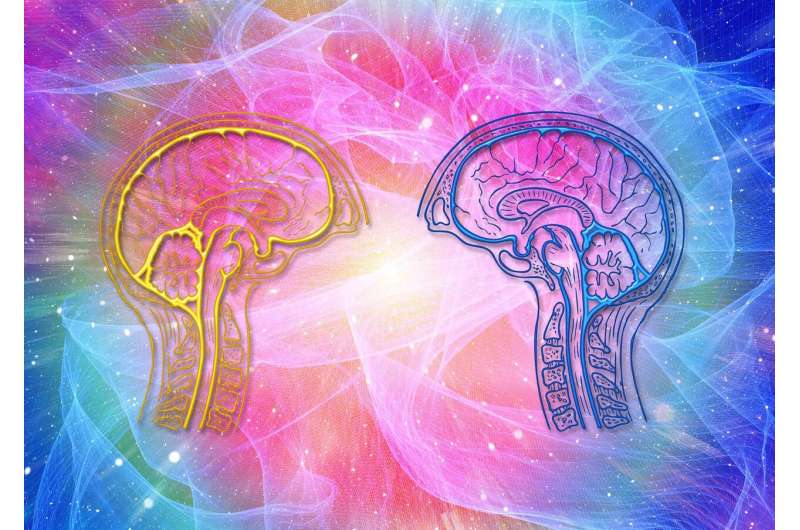This article has been reviewed according to Science X's editorial process and policies. Editors have highlighted the following attributes while ensuring the content's credibility:
fact-checked
trusted source
written by researcher(s)
proofread
Why elite athletes are harnessing their own brain waves for sporting success

The Olympic and Paralympic Games represent the pinnacle of athletic achievement, where the world's sporting elite showcase their prowess. Modern athletes benefit from top-notch coaching, optimized nutrition and recovery strategies. Yet, some are turning to more unique methods for the competitive edge—training the brain.
One brain-based approach that purports to aid performance and is gaining traction in elite sport is electroencephalographic neurofeedback. This technique involves placing small sensors on the scalp to record and display brainwaves in real-time.
The goal is to help athletes recognize and produce brainwave patterns that enhance focus, relaxation, or achieve a personalized optimal state for their skills. It's a bit like holding a mirror up to the brain. When the technology displays what is happening in the brain in real-time, people can easily experiment by bringing different thoughts or images to mind and they will immediately see how the brain signals change. It is through this process that they can learn to recognize different brain states and apply psychological strategies to help them to take control.
Athletes across various sports, including golf, football and archery have been experimenting with neurofeedback for years.
Does it really work?
At the Institute for the Psychology of Elite Performance at Bangor University, we have been studying the effects of neurofeedback across a range of sports and tasks for several years. In a 2015 study, we found that 12 amateur golfers improved their putting accuracy by 21% after three one-hour neurofeedback sessions.
In a similarly designed 2023 experiment, we found that six 30 minute neurofeedback training sessions helped 14 elite biathletes (the biathlon is a winter sport that combines cross-country skiing and rifle shooting) to self-regulate their brainwaves and increase their focus in the final seconds before dry-firing their rifles. But there was a caveat. In both studies, the improvements of the golfers and biathletes were similar to those in control groups who only practiced their sports without neurofeedback.
More promising results came from a 2021 study of ours with 40 adult volunteers. We asked them to cycle until exhaustion on an exercise bike after performing just 12 minutes of neurofeedback. Thirteen people were asked to produce a brainwave pattern that we thought would be conducive to endurance exercise. The other 13 were asked to produce a brainwave pattern which we did not think would benefit performance. The remaining 14 participants had to watch a neurofeedback recording without controlling their brainwaves at all.
The results were striking. The group who had been asked to produce the positive brainwave pedaled for 30% longer than the others.
To probe this finding, we invited the 26 participants from the first two groups back to our lab. They received the opposite neurofeedback treatment from our first experiment before they repeated the cycling test. The volunteers pedaled for an average of 11% longer on the day they received the positive neurofeedback treatment.
Despite these results, we still need to replicate the study with a larger sample and with more highly-trained cyclists. This would allow us to better understand whether this technique can yield benefits at the more elite end of sport.
Other research teams around the world have reached similar mixed conclusions to us about using neurofeedback training in studies of several Olympic sports. These include archery, gymnastics, speed-skating, ice hockey and golf.
In 2018 and 2024, research papers pooled the data from all studies to date and revealed evidence for modest benefits of neurofeedback overall. But thbe evidence for benefits was dampened when only well-controlled trials (those with balanced control groups to monitor for general practice or placebo effects) were considered.
So, in answer to the question of whether neurofeedback works—it might. The evidence shows plenty of exciting potential while recognizing that there is still important work to be done.
The next wave of research into this topic is already underway. Some studies are applying the research from sport neurofeedback experiments to try to make a difference elsewhere.
Early findings from our lab and others point to the feasibility of neurofeedback as a potential means to facilitate rehabilitation and to help with the recovery or management of symptoms associated with Parkinson's disease, stroke and chronic pain, among others.
So, while Olympic medals are cherished, if neurofeedback research could eventually lead to readily accessible and efficacious treatments beyond sport, that may well be the biggest prize of all.
This article is republished from The Conversation under a Creative Commons license. Read the original article.![]()



















